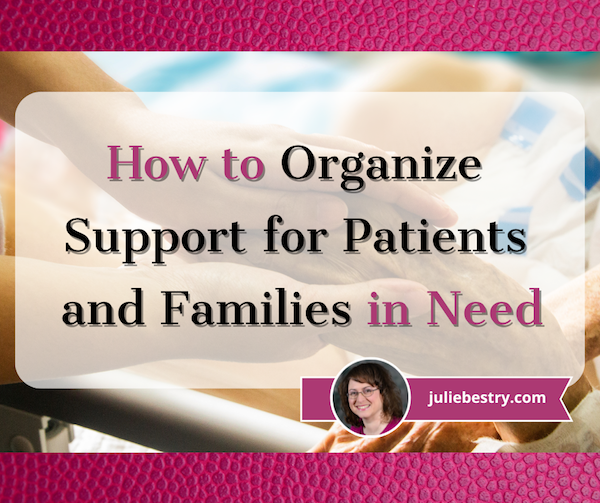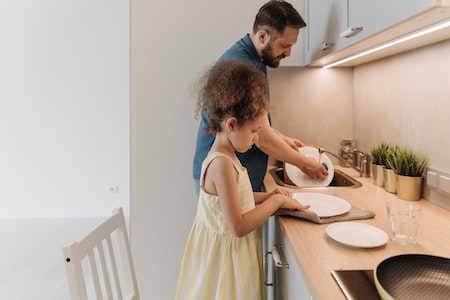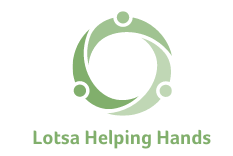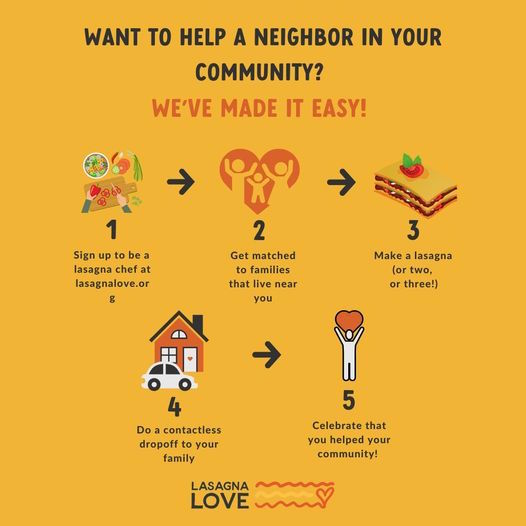How to Organize Support for Patients and Families in Need

The following anecdote from inspirational teacher, speaker, and author John Perricone has been making the rounds on the web:
Several years ago, I invited a Buddhist monk to speak to my senior elective class, and quite interestingly, as he entered the room, he didn’t say a word. (That caught everyone’s attention). He just walked to the board and wrote this:
“EVERYONE WANTS TO SAVE THE WORLD, BUT NO ONE WANTS TO HELP MOM DO THE DISHES.”
We all laughed. But then he went on to say this to my students: “Statistically, it’s highly unlikely that any of you will ever have the opportunity to run into a burning orphanage and rescue an infant. But, in the smallest gesture of kindness — a warm smile, holding the door for the person behind you, shoveling the driveway of the elderly person next door — you have committed an act of immeasurable profundity, because to each of us, our life is our universe.”
This is my hope for you for the New Year, that by your smallest acts of kindness, you will save another’s world.
Recently, I’ve had small acts of kindness on my mind. Some friends, both near and far, have been going through difficult times, and it has had me thinking about what I can do for them, especially when I’m not close enough to help do the dishes.

Dishwashing Photo by Pavel Danilyuk
Most of the time, our goal in getting organized it to make our lives easier and prevent unfortunate things from happening. However, sometimes, through nobody’s fault, bad things happen. People get sick or injured, or family member die, or people just go through dark times, and no matter how organized they were (or we were on their behalf), life gets upended.
When that happens, when a family member or friend is in bad shape and everyone has to pull together to help take care of that individual or their family, organization is the key to making everything a little less chaotic.
In today’s post, we’re going to look at some strategies and resources for helping when someone you know is sick or injured or recovering, and they or their household could use a little support.
ASSESS THE SITUATION
We can’t presume to know what someone else needs, even if we’ve been in the same situation, or even if we’ve helped that same person before.
An organizing client recently told me that she and her husband had needed little assistance after the birth of their first child, but experienced profound difficulties after their second was born prematurely. She was in the hospital for an extended ime, and the baby was in the NICU for months after that.
After the first birth, she needed only a little errand-running and someone to sit with the baby so she could shower or nap. After the second, she and her husband felt exhausted and overwhelmed, and needed support for everything from meals and childcare to housekeeping and someone to check if they’d paid the bills.
Most people will welcome some assistance, while others struggle with the idea of letting well-intentioned others make arrangements. So, talk to them or their caregiver to get a sense of what kind of support they will need, want, and accept. Common categories of assistance might include:
- Grocery shopping — Depending on the individual’s or family’s preference, you may perform a weekly inventory and create a shopping list to share with others helping to cook, or you might help the family set-up and learn how to use online grocery shopping apps and arrange for delivery by someone in the support network.
- Cooking — Whether you’re helping with meal preparation in the home, or cooking at your house and delivering, ensure that everyone’s dietary preferences and restrictions are considered. It does nobody any good to have a freezer full of pasta-based casseroles if someone has a gluten sensitivity. (As much as everyone is environmentally conscious, this is one time when using disposable containers to lessen inconvenience should be considered.)
- Cleaning — When you don’t feel well, messy or dirty surroundings will make everything worse. Imagine the relief of a clean bathroom and a tidy kitchen for someone spending most of their time at home or in medical settings.
- Childcare and transportation to/from school and extracurriculars — This might be a good fit for friends who are parents of the children’s classmates, but don’t forget to invite “aunties” and “uncles,” relatives or not. When things are stressful at home, whether there’s an illness or a new baby, getting a special day out with grownup who isn’t a parent or grandparent can make a child feel valued and like a VIP.
- Errand-running — Having someone who can dependably pick up prescriptions or make store returns ensures that the household can still run (somewhat) smoothly without daily stressors.
- Pet care — Fido and Fluffy may not be able to talk about their feelings, but you know they sense that something is going on. Some people in the support network might limit their efforts to feeding and cleaning up after pets, while others might be up for taking pets on an adventure to the dog park or the groomer.

Toddler Walking Dog by Robert Eklund on Unsplash
- Transportation to medical appointments — Imagine how uplifting it would be have a trusted friend take you to your appointments and feel, even for a little while, like the company you’re keeping with them is just a normal excursion!
- Serving as a scribe during medical appointments — Being ill is stressful, and it’s hard to focus when you’re not feeling physically and/or mentally at your best. Having a trusted, confidential friend available to take notes, and maybe even to ask questions if you see they’re looking confused, could be a huge comfort. (It’s a plus if the person has any medical background, like a retired nurse or PA, but in a pinch, you’d be surprised how much someone picks up watching two decades of Grey’s Anatomy.)
- Acting as entertaining/distracting company during chemo or other treatments, and during convalescence. Again, whatever someone can do to make a moment or an hour feel “normal” might be a blessing.
- Emotional support, both for the person and their caregiver(s) — This is an especially good category for loved ones who live at a distance. Having someone in the Pacific Time Zone who’s awake and able to offer a shoulder when everyone in your time zone is asleep gives patients (and their families) the chance get what they need without feeling burdensome. Encourage people who can’t participate in more formal support schedules or visit in person to be there however they can, even if that’s a card or a texted meme.
Read about others way to help.
How to Help Someone Who is Sick (An impressive list from the Kansas Health System)
How Not to Help a Friend in Need (New York Times)
50 Thoughtful Gift Ideas & Gestures for a Friend in Need (PrettyWellness.com)
Do not just ask, “What can I do?”
This puts the onus on someone whose mental reserves are already taxed to try to conceptualize what they need and try to feel comfortable asking for a favor. Instead, your goal is to to say, “Here are the things we’ve thought of. What are you comfortable letting us do? Is there anything we’ve forgotten that we could add to the list?”
CREATE A SUPPORT NETWORK
Even if you’re the sibling, the in-law, or the best friend, you can’t do it alone. If someone you love is going through any kind of illness, treatment, or recovery, or is otherwise in a difficult position (for example, is in grief or suffering depression), you can’t be the magic wand that solves all the problems. What you can be is a project manager so that, together, you can all maneuver that wand to make a little comforting magic.
Gather your community.
With the permission of your loved one and/or their partner or caregiver, reach out to friends, family members, neighbors, and colleagues to see who is willing and able to help. Use social media, email, texts, or phone calls to inform people what you’re trying to do and why, and ask for their support.
Make clear that you’d much rather someone take on a smaller role and be able to contribute than to take on too much and not be able to provide what’s promised when the time comes.
Don’t presume that everyone is equally skilled and comfortable with all tasks. Provide a list of the tasksto be completed, and ask individuals to state where and when they’re able to help. People who love to cook will find it easy to “make double” when preparing meals, while those with flexible schedules and a love of kids will probably be eager to play taxi from school to ballet or soccer and then home.
Coordinate a schedule.
Once you have a group of people who are ready to help, you’ll want to establish a schedule that ensures the person you’re supporting receives consistent help without overwhelming any one individual.
This may involve setting up rotating shifts for different categories of tasks or assigning specific days to different people. Some in the network will have a great deal of flexibility while others can only help on weekends or evenings. Meet people where they are.
Communicate clearly.
Once everyone is on-board with providing support, select a method to ensure clear and open communication.

Rotary Phone by Sam Loyd on Unsplash
Different people (and definitely different generations) have decidedly varying communications preferences. Boomers and retirees might not mind phone calls, while GenZ and Millennials (and folks with jobs that require a lot of intense focus) are more likely to prefer texting or emails, so they can reply at their convenience. Create a master list with everyone’s name, phone number, email number, and preferred contact method, and if everyone is amenable, share it as a spreadsheet in Google Drive or a note in Evernote.
Sometimes, you’ll want to communicate with the entire group rather than individuals, and email might work best. There are also online platforms (as we’ll discuss below) to help develop support calendars, allowing individuals to sign up for the tasks and times that work best for them.
Communicate with the person/family, too. If people are going to be showing up to drop off food, make sure they know the schedule, and get the OK for how things get delivered or accomplished. They may prefer that nobody come to the house before 10 a.m., or that meal deliveries come to the side/back door (which may be easier for a recovering person to access), or that they get a text ten minutes in advance of anyone showing up.
Remember the importance of privacy and confidentiality.
I can tell you from first-hand experience that being a patient, whether for an acute condition or a chronic one, means having to give up far too much privacy and dignity. Remind and encourage everyone involved to respect the individual’s confidentiality. Someone may feel great about having delivered three days of meals to the family and want to share that warm fuzzy on social media, but nobody’s humblebrag should come at the expense of another person’s privacy.
Of course, it should go without saying that only the individual you’re supporting (or, if applicable, the family) should be sharing medical updates (unless a proxy is asked to do so).
Consider crowdsourcing professional support.
Depending on the individual’s needs, the support community may want to provide funds to help accomplish professional work when the individual in crisis is unable to perform their usual tasks. Help might include a professional organizer for household functionality, a daily money manager to keep up with finances, or an academic tutor for the children.
Your network might want to gift the individual in-home massages or salon services (manicures, hair/scalp care, skin care, etc.) to boost their spirits and support their physical well-being.
Embrace flexibility.
As you likely know, health conditions can be unpredictable and do not abide by the calendar. Be prepared to adapt and reconfigure the support schedules as needs change.
USE SUPPORT RESOURCES THAT ALREADY EXIST
There’s no need to reinvent the wheel. Take advantage of resources that can complement the efforts you’re already making.
Meal and Support Scheduling Platforms

Caring Bridge — One of the best-known platforms of its kind, Caring Bridge exists to help provide updates during a health crisis. It’s like a cross between a personalized web site and social media in that family or assigned parties can create posts updating someone’s health status and needs, and others can provide supportive comments. However, Caring Bridge also has a planner that allows volunteers to offer help with all the categories described above.
Caring Bridge is free to use, has no advertising, and is a non-profit.

Meal Train — This calendar platform lets family, friends, neighbors, and colleagues sign up to provide meals for the person/family in need. It takes a lot of the administrative weight off of whomever is project-managing the family’s support, and Meal Train provides a straightforward way to organize and coordinate meal deliveries to ensure that the patient is getting nourishment and that the household isn’t eating takeout pizza for weeks on end.
- Create a free Meal Train page for the person/family whom you’re supporting.
- Enter the dates when meals will be needed.
- Fill in all of the preferences including favorite foods, food allergies/sensitivities, and the ideal drop-off times to avoid disturbing the patient or family.
- Share the Meal Train link with everyone in the support network so they can sign up to provide meals.

Members of the support network might benefit from reading some of Meal Train’s helpful articles, like:
11 Trips: Meal Train Etiquette for the Savvy Participant
6 Tips for Delivering your Meal
When Dropping Off a Meal, Should I Stay or Should I Go?
Although Meal Train is free, there’s a Pro level for $15/month for groups that might need to oversee multiple support pages. For example, if your house of worship or community group makes a point of supporting families in need, Meal Train Pro is an option.

Lotsa Helping Hands — is similar to Caring Bridge and Meal Train in that it supports the creation of a caregiving community. You can organize and coordinate all of the cooking, cleaning, errand-running and other tasks described earlier in this post, and individuals can sign up to provide support based on the person’s/family’s specific needs and each individual’s capacity.
The platform includes a care calendar for volunteers to sign up for tasks, an announcement page for updating everyone on progress or setbacks, a “well wishes” pages for sending messages to the patient and family, and a photo gallery for sharing supportive pictures.
Specialized Platforms
Not everyone makes an ideal volunteer for providing meals. But just because you (by which I mean I) can’t cook doesn’t mean you can’t provide a meal. Sure, you can use a service like Door Dash or GrubHub to dial up a person’s favorite restaurant meal and have it delivered, but sometimes you want a person to have a real home-cooked meal, even if you know they’re better off not having it cooked in your home.
To that end, I was delighted to discover Lasagna Love.

Lasagna Love provides delicious lasagnas for those in need. It might be for a patient, a family who has had a new baby, or even for someone you know who is just going through a really rough patch. Lasagna Love is a bit of a community, itself. You can:
- Request a lasagna for yourself or someone in need — Search by zip code to see if Lasagna Love is operational near you. You’ll get matched to a local lasagna chef to coordinate a date and time, and then you’ll get a safe and contactless delivery of lasagna!
- Volunteer to make lasagnas for people who have requested them.
- Donate to the cause!
- Sponsor a lasagna chef through Patreon.
The site describes its efforts this way (emphasis mine):
Lasagna Love is a global nonprofit and grassroots movement that aims to positively impact communities by connecting neighbors with neighbors through homemade meal delivery. We also seek to eliminate stigmas associated with asking for help when it is needed most. Our mission is simple: feed families, spread kindness, and strengthen communities.
Something tells me that the Buddhist monk in John Perricone’s classroom would approve. After all, if you’re making the lasagna for someone who needs it, it’s goes one step beyond helping Mom do the dishes. It’s may be a small act of kindness, but one with huge potential results.
If you think you’d like to become a lasagna chef, learn how to get involved at the website and take a peek at the simple graphic, below.

Make lasagna once or become an ongoing lasagna chef or find a balance somewhere in between. Hear more directly from Rhiannon Menn, the founder:
While Lasagna Love was a brand new concept to me, the next resource is the one I’ve known about the longest, and have been gratified to recommend it to clients and others who have sought referrals.

Cleaning for a Reason — This 501(c)(3) nonprofit organization provides free home cleaning to patients battling cancer.
Cleaning for a Reason connects its trusted network of 1200 residential cleaning companies, cleaning industry volunteers, and community volunteers with cancer patients and their families to provide a clean, healthy environment.
Patients or their loved ones can apply for two free home-cleaning sessions and use this page to find a service provider. Cleaning for a Reason serves all individuals and families with any type of cancer, and patients are eligible if they’re recovering from cancer surgery, in cancer treatment, or in hospice care.
Cleaning for a Reason allows applications to be submitted by family, friends, and colleagues, as well as caregivers, doctors, and nurse navigators, but asks that you first verify that the patient is willing to accept the services.
Hear more from the founder, Debbie Sardone:
You can read about the program at the Cleaning for a Reason site and on the Facebook page.
If someone you care about is ill or going through a difficult time, anything you do to let them know they are loved and valued will help. However, if you’re able to project-manage or volunteer by providing organized and consistent support, it will make a significant difference in their well-being during challenging times.
Whether you do the dishes, make a lasagna, organize the troops, or come armed with two boxes of tissues, it’s worth repeating: “By your smallest acts of kindness, you will save another’s world.”




Thank you for sharing all this important information, Julie! When people want to help, the main reason they don’t is they feel they will step on another person’s toes. Giving the other person the opportunity to determine what help they need transfers the power to the person needing the help.
Giving a few suggestions on things that one can help with may spark some ideas too. Loving support is always helpful for the one who needs it, even if they feel they do not need anything. But it must be consistent, like every day or once a week.
Thank you for your kind words, Sabrina. You’re right — fear of doing the wrong thing often keeps people from doing the right thing. So, I’m hopeful these tips will empower people to take action in the most helpful (and as you note, consistent) ways.
What a caring and thoughtful post!
I’m active in my church where I have been a member for more than 30 years. Our Deacons coordinate this kind of care for our members, and so a lot of this feels quite automatic. We set up Meal Trains and coordinate rides to doctors, home visits, and more on a regular basis.
I’ve learned that one thing people often need is someone to run to CVS and pickup medications, so I often text that as an idea of what I can do. Same for a grocery run. If the illness is a “long haul,” I see that families get into a new rhythm, and then the needs can shift. For instance, a dear friend is battling pancreatic cancer. I check in periodically, and this time when I offered errands, she said her husband was taking care of that. I asked what she desired that wasn’t being covered, and she said she was looking for someone to come and walk with her. Her daughter was unavailable, and she didn’t want to take the walk along (just in case). I was so delighted by this specific request, and was able to hop in the car and walk with her the same day.
Often people don’t know what to ask for, so I really love your idea of making a list and asking people what they feel comfortable having done for them. The onslaught of concern and offers is lovely, but managing that can be overwhelming too!
It’s wonderful that the community in your house of worship formalizes this kind of support network! And you obviously have a great approach. I hope you and your friend enjoy many of these walks, now and after she recovers.
And yes, managing offers is overwhelming, which is why I hope this kind of advice will help readers step in to project manage/supervise where they can. Thanks for reading!
What a beautiful post, Julie! It’s true that when a person or family is in crisis, it’s not always obvious the best way to help. You provided so many terrific ideas and options. I especially like what you said about asking and listening to what a person needs. But also be mindful that it could be challenging for them to ask. So having a list of specific things you can offer, like running errands (CVS, groceries, picking up the kids), is excellent.
I’ve been both the recipient and the giver. While grieving after my mom died, one of my friends called me up. She said, “I’d like to send over dinner from ‘x’ restaurant. What time and day would be good for you?” It was specific, generous, and so much appreciated. She also asked about any particular allergies and took charge of ordering. It was a lovely gesture and removed the burden of making or deciding about dinner when I wasn’t at my best.
I’m familiar with CaringBridge but didn’t realize they had scheduling capability. That’s a great feature!
I’ll keep this post to refer to in the future. Thank you for all the terrific resources and sensitivity to this topic.
Thank you for your kind words. Yes, I definitely agree that you have to strike a balance; offering options so someone doesn’t have to think of anything gives them a chance to recognize that you really do want to help and aren’t just “being polite.”
And you’re so right that specificity matters. The less vague the offer — and in your example, setting everything up and just letting the individual pick their preferred options — is a great focus.
Thank you so much for reading.
Julie, I love how you put this together. My favorite thing is that you gave me ways to offer my assistance. I’m the sort of person who may say ‘how can I help’ not realizing that they can’t come up with something quickly. Having a list of things to offer to do is so much better. I’m printing this post so I will be able to refer back to it as needed. Thank you.
Oh, Diane, I am so flattered by your kind words. You have such a big heart that I have no doubt anyone you ask, “How can I help?” will feel at ease telling you, but yes, giving agency to people while offering prompts does seem to be the best balance. I loved researching this topic, which all started when I learned about Lasagna Love, and it all flowed from there!
Thank you for reading!
What a great post! I love how you explain all the different ways a person can help. We all have our strengths.
Thanks, Jill. Sometimes it’s hard to know what to do, but we can all do something, and all those “somethings” add up. Thank you for reading!
These are all wonderful resources! I am very appreciative of the list of potential ways to help. It’s a great reference for when we want to help a loved one, but don’t know where to start. Referencing that list to brainstorm ideas specific to the person I want to help will be a lot more helpful than the “How can I help” question.
Phaedra, that’s exactly what I was hoping when I started to lay out this post. (To be honest, it started with finding out about Lasagna Love and it all developed from there!)
I’m really hopeful that this post will help others help more people. Thanks for reading!
I love that quote–I can barely get my kids to help me with the dishes! I always say, “Think Globally. Act Locally.” And local in this case is my kitchen sink!
Organizing support for others–a great idea for a blog post. It’s hard to know exactly what people need when they’re sick, in mourning, or caring for a loved one. You’ve offered your readers a wide assortment of options to aid in helping others.
I remember when my second child was born and I wasn’t allowed to drive afterward for weeks, I asked a few local friends to drive me and my newborn and toddler back and forth to preschool. Who needed another bib or blanket? I needed drivers! Ask and ye shall receive…
It would be hard to get more global than that kitchen sink, Stacey! And you’re so right, asking for what you want should be normalized, but too few people feel “safe” doing more than accepting whatever is given, even if it’s not what they need in a difficult situation. Thanks so much for reading and sharing your thoughts!
Julie, such a wonderful post. I have just this past week seen this community of help happen. My husband went for a doctor visit to his oncologist to look at options for treating a new cancer. The doctor said that before we could do anything more (due to scaring and damage done by previous treatments) my husband would need a trach and a peg tube for feeding. He admitted Rob right then into the hospital where we stayed 6 days.
Upon dismissal, I was exhausted and overwhelmed. While in the hospital Diane Quintana took over both a class and a support group that we do as a team. She kept the business rolling and also kept checking in on me. Another friend came by the same evening we got home and brought me some soup. She has brought a meal every day since then. Another friend and fellow organizer came over the next day and helped me organize and find homes for the ton of stuff needed for Rob’s care.
Other friends are available – all I need to do is ask.
My tribe is AWESOME!
First, I am so sorry Rob and you are going through this. It’s been such a slog for you guys and I hate that you have to keep dealing with hospitals. Diane is a fabulous person (and you guys are deserving of fabulous care) and I’m so glad your other friends have been available. I’m sending hugs across the miles.
I’m sending healthy and calming thoughts.